[New York] The sanctuary at Temple Emanu-El on New York’s Upper East Side is a landmark of Reform Judaism. The majestic 103-foot-tall structure has detailed architecture, dozens of stained-glass windows, and rows of wooden pews capable of hosting no fewer than 2,500 people. But since March 2020, it hasn’t seen the usual crowds. Two years into the COVID-19 pandemic, every other row remains blocked off by a red ribbon and more people are following Shabbat services online than in person.
“It will be filled again,” Rabbi Joshua Davidson, who has served as Temple Emanu-El’s spiritual leader for almost a decade, said with confidence, staring at the empty grand space.

“It will be filled again,” says Rabbi Joshua Davidson, staring at the empty grand sanctuary of Temple Emanu-El in New York. (Courtesy)
Attendance at US houses of worship is still far from the pre-pandemic numbers. In-person church attendance is down 45% since the pandemic began, according to an ABC News analysis across more than 3,000 US counties of cellular phone data provided by Safegraph.
‘Two lost years’
As the coronavirus began halting daily life across the globe in March 2020, Davidson faced the tragedy at his own congregation. Dozens of Temple Emanu-El’s members died from the virus and dozens more lost loved ones.
“People couldn’t even grieve the way they wanted to,” he recalled sitting in the sanctuary. “I officiated at burials where parents couldn’t even hug their kids while they looked at a spouse or parent being buried. It was horrendous.”
Like many people, Davidson has had to isolate himself from others, a very unnatural move for a religious leader.
“I’ve had to get used to leading worship in an empty sanctuary and looking at the camera instead of looking at the congregation,” he said. “That was hard. I did get used to it; I hope I get unused to it.”
While for Reform Jews, online streaming and the ability to use technology on Shabbat proved to be somewhat of a relief, Orthodox Jews like Eli Steinberg of Lakewood, New Jersey faced a painful challenge.
“It was the longest I had ever been away from shul,” Steinberg told The Media Line by phone. “I’m kind of a fanatic about davening [praying] in shul. I usually don’t daven on my own, so this was a very big difference for me.”

Eli Steinberg (center), Lakewood, New Jersey. (Courtesy)
As an Orthodox Jew, he explained “your day revolves around [praying in the synagogue].” In fact, Steinberg purchased his home specifically because it was in the same neighborhood as the synagogue he wanted to attend. “It’s a foundational and very important part of life,” he said.
During the initial stages of the pandemic, Steinberg and his community focused on “trying to maintain as much religious practice as we can in a safe way.” The first step was establishing spacing and capacity limits in the synagogue, but as more confirmed cases of COVID-19 emerged in the community and lockdown rules went into effect, they began praying outdoors.
“The idea was that if everyone is in a self-contained space like a porch on their own property, it would be okay,” he said. “In terms of Jewish law, to be considered a minyan [quorum of 10 adult males] one of the primary opinions is that as long as you can see each other it’s good enough.”
Steinberg started to pray in his backyard, joining with people from the next street over. “To me, it was a very big thing when I was finally able to pray [with others],” he said. The focus of his community, he added, was always “to get things back to where they should be ideally.”
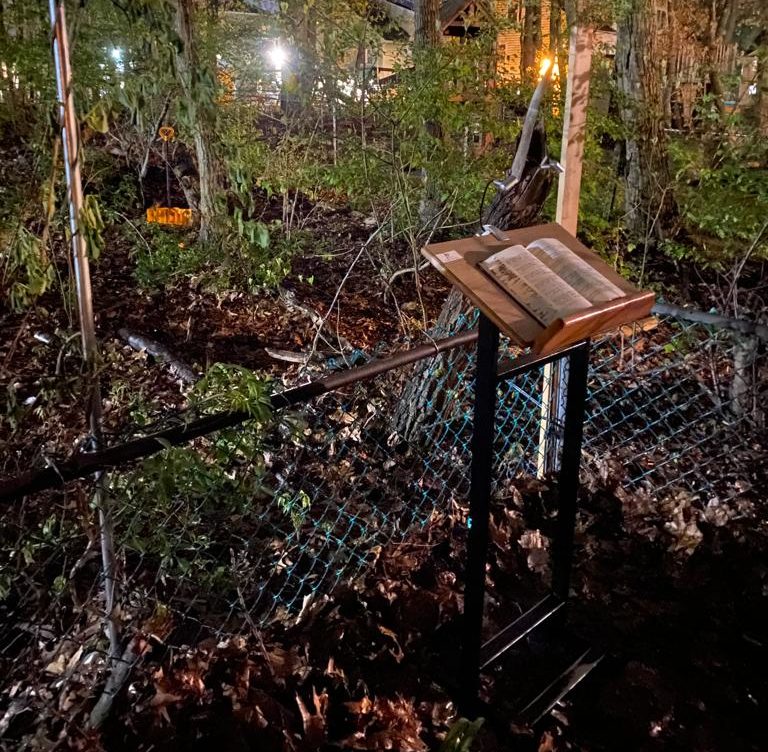
Eli Steinberg set up a lectern in his backyard to hold his prayer book during outdoor services in Lakewood, New Jersey. (Courtesy)
Just two blocks away from Temple Emanu-El, the Reverend Stephen Bauman of the Methodist Christ Church on Park Avenue also said that being “bereft of physical contact” was the most difficult part of the lockdown days.
“My belief is that religion at its best is a communal project,” Bauman, who describes himself as a “people person,” told The Media Line in his office. “We were all just adapting.”
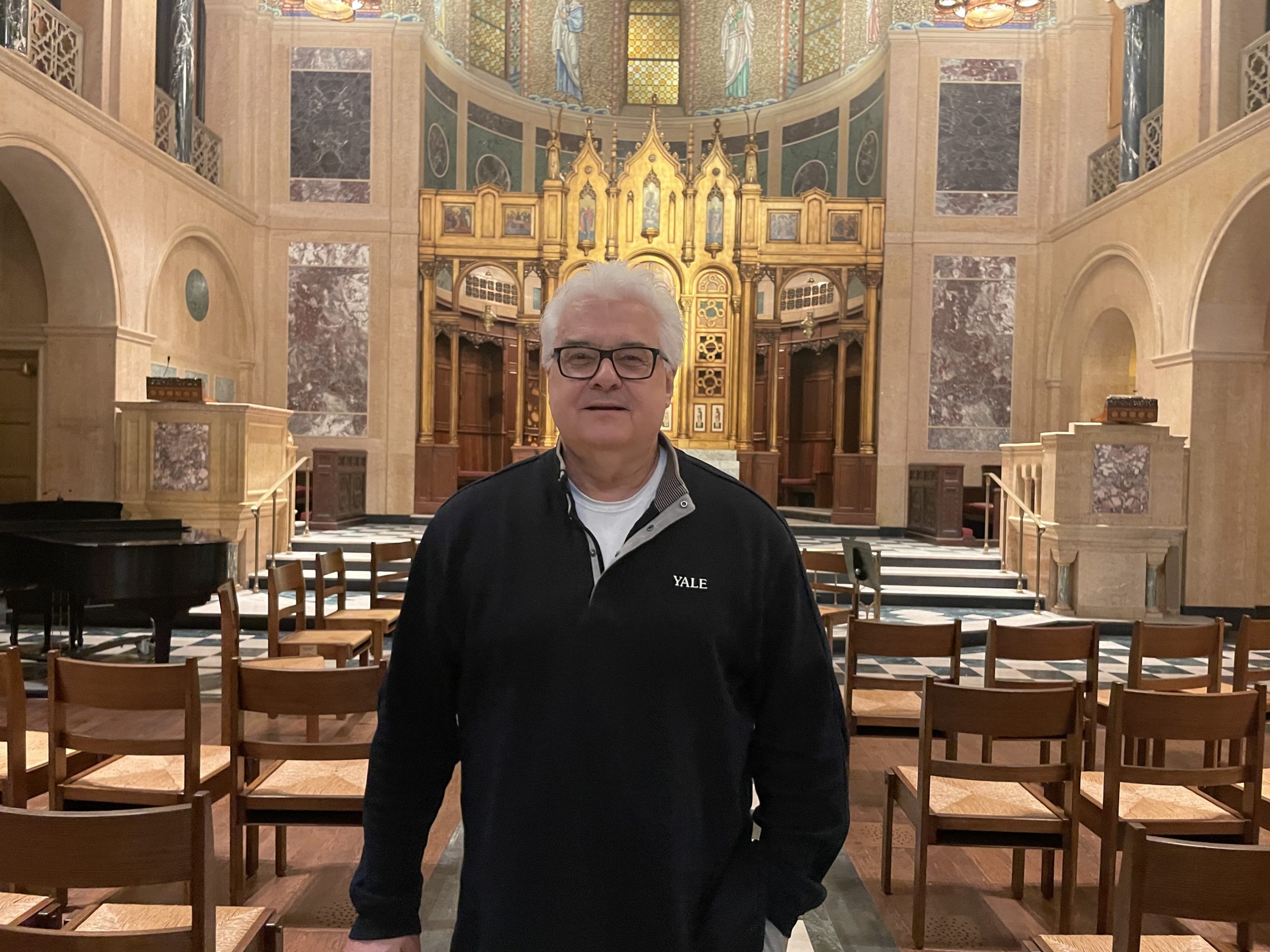
Rev. Dr. Stephen Bauman at Christ Church NYC. (Courtesy)
As his church closed down for the first time, Bauman and his wife isolated in a home they own upstate New York. “Personally, it was okay but professionally it feels like two lost years,” he said.
Imam Chris Caras has been the spiritual leader at the Islamic Center of Pittsburgh for two and a half years. He began in his position in August 2019, shortly before the coronavirus crisis began. The center, housed in its current building since the 1990s, is located near the University of Pittsburgh, a central location with a very diverse community. Caras estimates the prayer hall can fit some 800 worshipers.
“News had started trickling in like a domino effect of people who had closed their mosques for Friday prayers,” Caras recalls about March 2020. “This happened right before the month of Ramadan.”
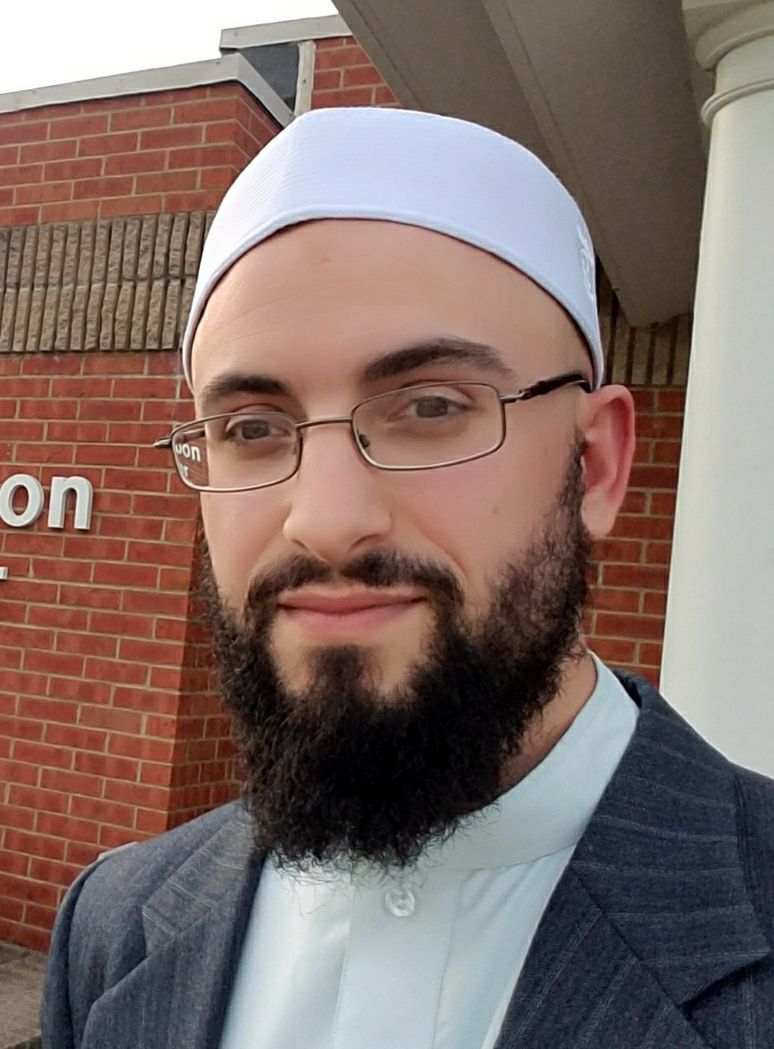
Imam Chris Caras, Islamic Center of Pittsburgh. (Courtesy)
Caras’ mosque closed its doors as well. He said the first few weeks of the lockdown helped him to take the time to work on himself. He started learning how to use Zoom and livestream content on YouTube to “keep tabs with the community as best I could.” The mosque only resumed services in June 2020, with COVID-19 measures in place. “We faced apart instead of praying side by side,” he said.
The crisis has taken its toll. “I feel like I’m going to punch someone the next time they say, ‘Due to a rise in COVID cases we are switching to virtual’ or postponing or canceling,” he said. “I’m just really tired of hearing that expression.”
Reinventing religious practice
Not all clergy agreed to comply with COVID regulations. Pastor Tony Spell of Baton Rouge made headlines over the past two years for refusal to adhere to emergency orders. He’s been arrested 33 times for it.
Although he once tried to hold services outside in the hot Louisiana weather, Spell quickly became known for flouting pandemic restrictions. “It is very disheartening to have six policemen pull the Bible out of your hand, put you in handcuffs, and fingerprint you,” he said. “It was an attack on all religions.”
Spell, who runs the 63-year-old Life Tabernacle Church, said the vast majority of his congregants embraced his decision to conduct business as usual. This helped the church grow at a time when most shrank, he added.
“People came in from across America and different parts of the world to our church service because it was open,” he said. “Some people relocated here from California, New York, Kentucky, where the real tyrants were.” In his church, “very few people wear masks” and there are “no vaccines.”
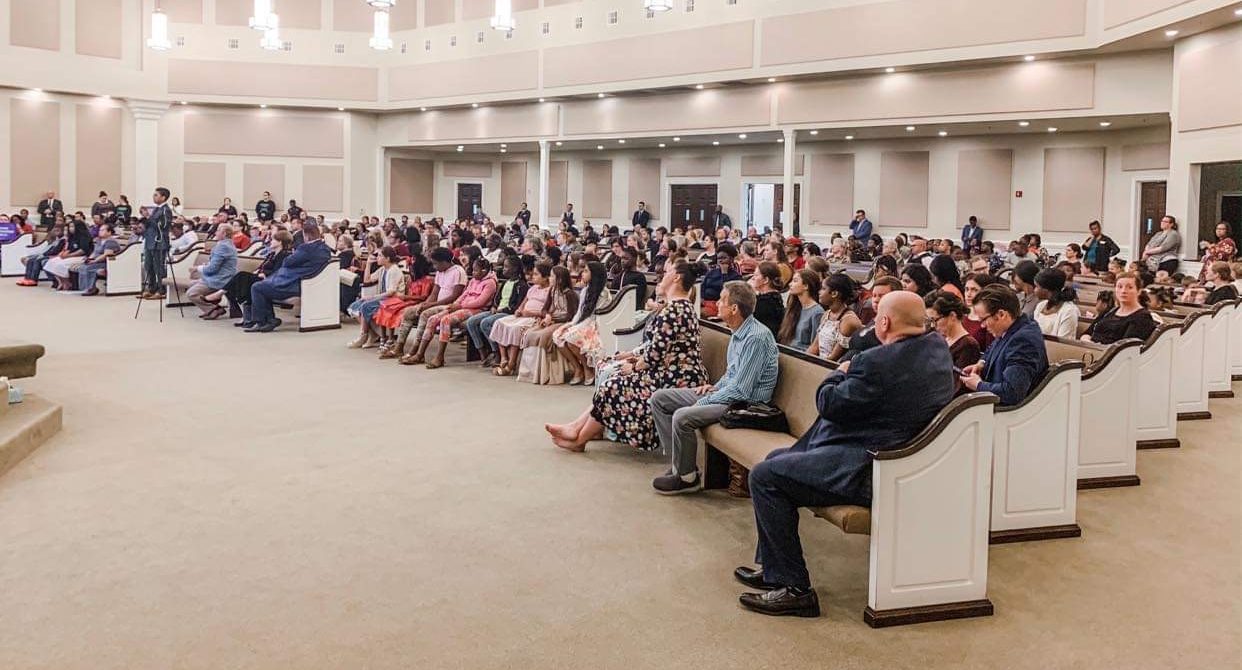
It is business as usual at Life Tabernacle Church in Baton Rouge, Louisiana. “Very few people wear masks” and there are “no vaccines,” says Pastor Tony Spell. (Courtesy)
While Spell’s approach is not unique, it was rare in the US during the initial lockdowns. Most houses of worship found ways to reinvent themselves and stay within the rules.
In the sanctuary at Temple Emanu-El, several monitor screens are now placed by the pews and under the pulpit. They are used to broadcast the service over Zoom for people who can’t be in attendance.
“Necessity is the mother of invention,” Davidson said.
The rabbi believes that while “the synagogue as an in-person community will always be definitive of what congregational life is about,” the tools and skills the community acquired over the past two years will continue to be used to reach people.
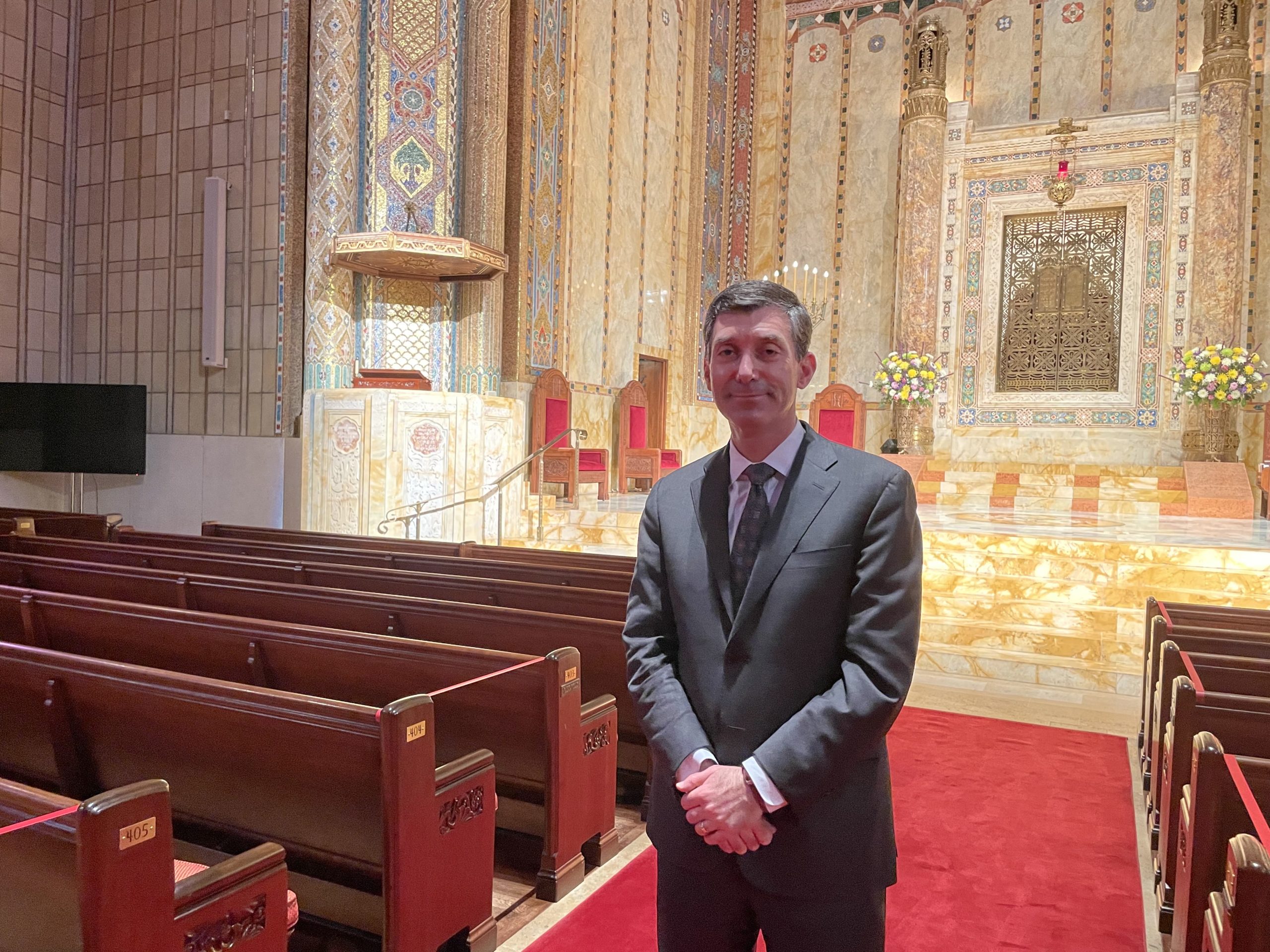
Rabbi Joshua Davidson, Temple Emanu-El, New York. (Courtesy)
“What about all the homebound congregants that we know we have? These tools have offered them an opportunity to become part of the community in ways that they hadn’t been able to before,” he said. “It’s been a time of extraordinary invention and I don’t think synagogue life will ever be quite the same because of it. It will be better and broader.”
Before the coronavirus, Bauman’s church had no virtual experience. They had to learn fast. They held small study groups on Zoom and prerecorded and packaged broadcasts for Sunday services.
“I think when people are bewildered, they are looking for ways to ground their experience, and the virtual experience did provide that fortunately,” he said.
However, a significant challenge arose for the church. They grappled with the question of Communion, and how to conduct the ritual in the virtual world.
“Communion is the central sacramental activity in Christianity,” Bauman explained. “If I’m doing the ritual and you’re at home and you have your own wine and bread, is this an efficacious event?
“When we could not meet, I felt it was the only option, so we did virtual Communion, but now that we can be in person, I don’t,” he continued. “It was an act of necessity at the time.”
Caras never conducted Friday prayers on Zoom. He gave livestream talks on Fridays at the time he would normally give his sermon but did not want his congregants to conflate this with the religious ritual because “the Friday prayer has to be done in congregation at a place that is publicly accessible with a certain quorum.
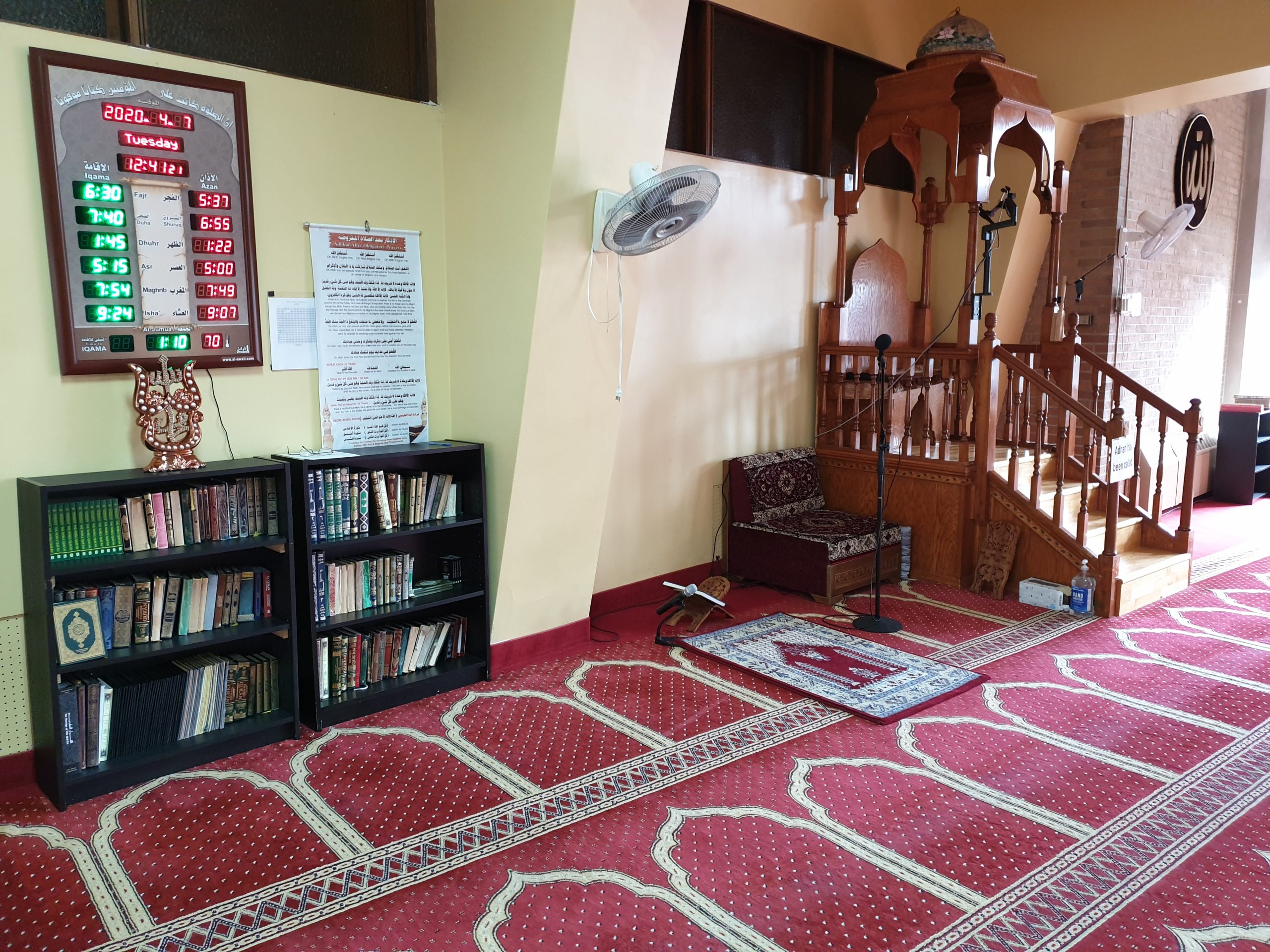
Islamic Center of Pittsburgh. (Courtesy Imam Chris Caras)
“Normally in our faith, you cannot step in front of the imam while leading prayer,” he explained. “So, for example, if I’m leading my prayer in my house on Zoom, then someone [praying along] might be a couple of inches in front of me but maybe they are 5 miles in front of me.”
The cost of ‘fantasy reality’
Christ Church’s sanctuary was undergoing renovations when the pandemic hit. With its 14,000 sq. ft. of Venetian mosaic and 34 kinds of marble details, it is a grand space. Although Bauman said the church has around 800 members, since it reopened in July 2021, in-person attendance is less than half of what it was before the health crisis.
“The question looms large: What does church look like on the other side? No one knows,” he admitted.
Although he believes “virtual is here to stay,” Bauman refers to it as a “fantasy reality that feels real but isn’t because it is devoid of all of what it means to be human.
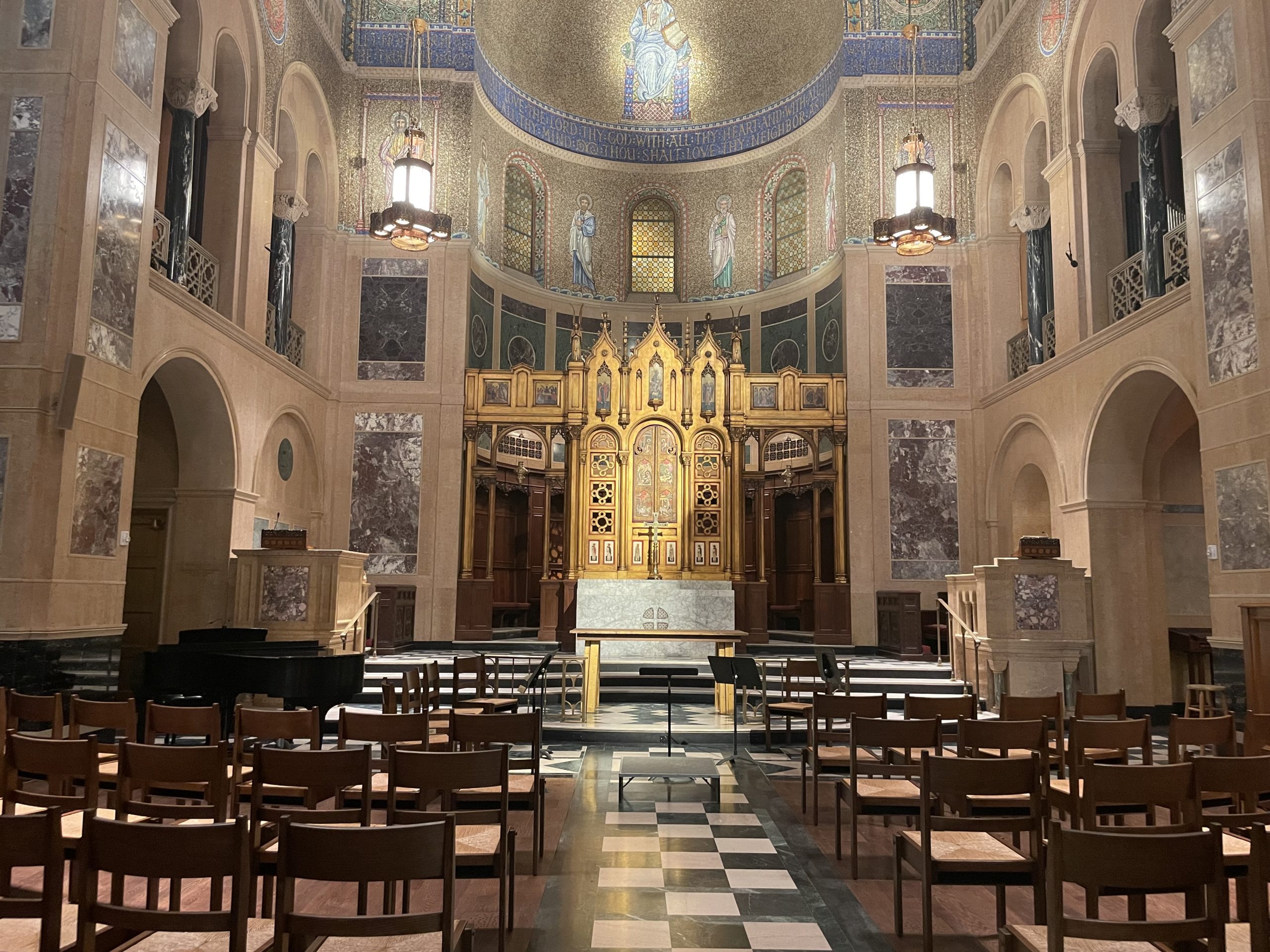
Christ Church NYC. (Courtesy Rev. Dr. Stephen Bauman)
“I have a much larger virtual audience than I have here on Sundays right now, and they might be in California or in Australia,” he went on. “I’m not sure what that means to have someone say they are a member in Miami watching a streaming: Am I a [reverend] to them? No. Do they contribute? No.
“There is a whole segment of the Christian church that is going to leap into the metaverse completely and I think to myself: We are losing something fundamental,” he said. “I could also see a real countermovement happening where people are divesting themselves from that.”
In the summer of 2020, David Kinnaman, president of the Barna Group, an evangelical research and resource company located in Ventura, California, predicted that one in five American churches will close after the pandemic. Already in 2019, the group conducted a survey showing that church membership was declining among young people and 10% of all Americans saw the church as irrelevant.
But looking at the striking sanctuary, Bauman isn’t too worried. “A place like this will never go away,” he said. “It is here, and it will always serve a useful purpose, and it probably will discover a reinvigorated life in the coming decades, at least that’s what I predict.”
Bringing worshipers back to the Islamic Center of Pittsburgh has also been a real struggle for Caras.
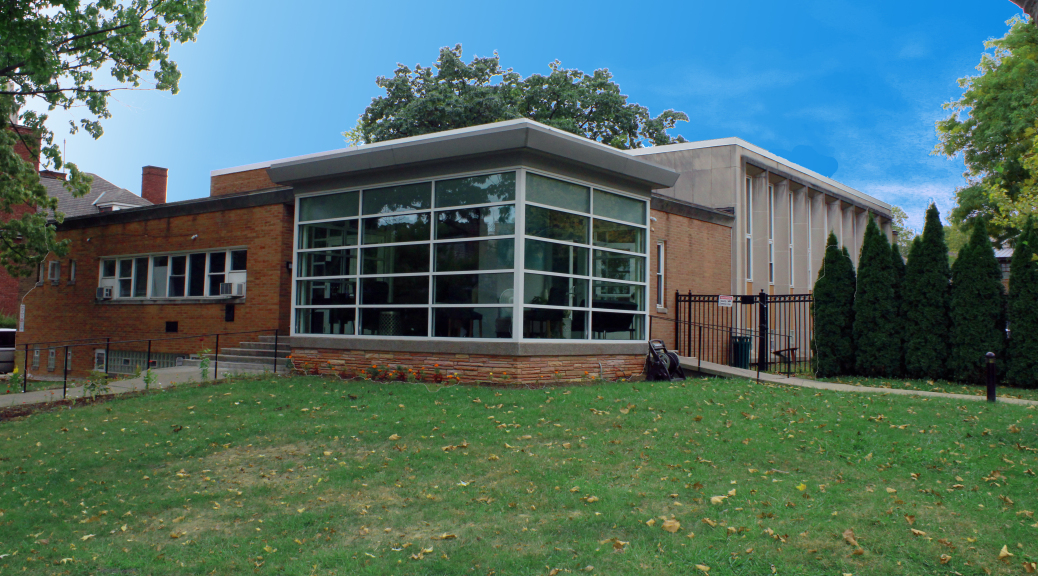
Islamic Center of Pittsburgh. (Courtesy Imam Chris Caras)
“I think a lot of folks have just gotten comfortable with joining meetings online via Zoom, and so it’s difficult to tell people they should get in their car and drive 15 minutes through the tunnels and bridges and under the overpasses of Pittsburgh in the cold winter to get to the mosque,” he said.
“In the very beginning it was almost like we had to force people to stay out of the mosque, but now it’s the exact opposite,” Caras said. “Every so often someone will say, “Oh, you guys are open now?” Yes, we’ve been open for months, where have you been?”
At Life Tabernacle Church, Spell decided early on against livestreaming because he believes it “promotes church absenteeism.
“You look at the pope, and the Vatican and the evangelicals: They can’t get people back in the pews, because they told them church attendance is not essential,” he said. “Well now you can’t get them back, how does that feel?”
Louisiana’s Supreme Court is set to hear arguments later this month on Spell’s attempt to fight the criminal charges against him for flouting the state’s COVID-19 restrictions.
“You cannot be a church without assembly, period,” he said.
With Davidson’s services being available online, he has reached thousands over the past two years. He remains optimistic, however, about people coming back to Shabbat services soon. But the trauma and anxiety that many experience about COVID-19 is “going to have to pass before people feel comfortable coming back,” he said.
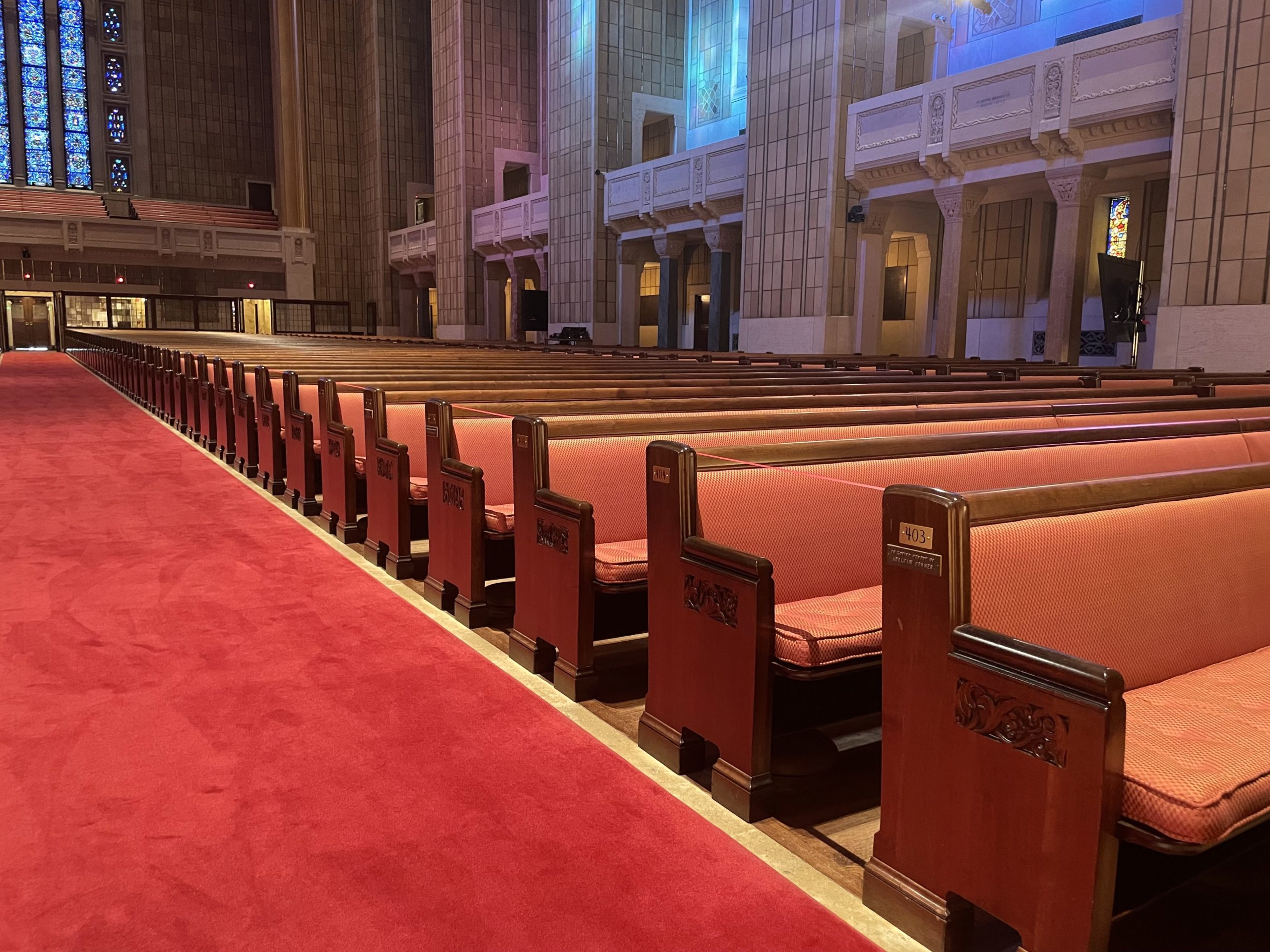
Every other row is blocked off by a red ribbon at Temple Emanu-El, New York. (Courtesy Rabbi Joshua Davidson)
“There has never been a moment in Jewish history where once the danger of gathering had passed, that the Jewish community didn’t reconvene in even greater numbers,” he added.
According to Davidson, many members of the temple connected to their Judaism in new ways over the past two years. Some started reading Jewish books that they hadn’t opened before. Others began observing Shabbat as a way of disconnecting from the workweek, which had now moved into their homes.
“People needed a spiritual anchor and many of them needed a framework,” he said. “Religion can offer that.”
Temple Emanu-El currently hosts some 200 people on a Friday night, still far from the 400 it had before 2020. “For people who say, ‘I can’t wait to be there,’ my response is, ‘I can’t wait to see you,’” Davidson said. “For people who say, ‘I’m not quite ready,’ my response is, ‘We’ll be here when you are.’”
6 million deaths worldwide
Worldwide, 6,003,619 people have died from COVID-19 since the start of the pandemic. This figure represents confirmed fatal cases. But because cases are underreported in large parts of the world, the Institute for Health Metrics and Evaluation at the University of Washington estimates that the actual global death toll exceeds 15 million.
The United States has to date experienced 80,843,570 confirmed cases of COVID-19 and 981,729 deaths from the disease. A total of 54,136,964 people have recovered, and there are currently 25,724,877 active cases in the US.
Here are the latest COVID-19 numbers for the Middle East and North Africa as of 11:10 am Greenwich Mean Time (UTC±0) on Friday.
| Country | Confirmed Cases | Deaths | Recovered | Active Cases |
| Afghanistan | 174,214 | 7,619 | 157,199 | 9,396 |
| Algeria | 265,130 | 6,848 | 177,732 | 80,550 |
| Bahrain | 521,613 | 1,456 | 494,414 | 25,743 |
| Cyprus | 328,657 | 861 | 124,370 | 203,426 |
| Djibouti | 15,549 | 189 | 15,357 | 3 |
| Egypt | 487,642 | 24,149 | 417,479 | 46,014 |
| Iran | 7,073,747 | 137,439 | 6,696,494 | 239,814 |
| Iraq | 2,306,092 | 25,028 | 2,250,904 | 30,160 |
| Israel | 3,653,608 | 10,239 | 3,585,292 | 58,077 |
| Jordan | 1,638,228 | 13,849 | 1,546,429 | 77,950 |
| Kuwait | 621,466 | 2,541 | 611,381 | 7,544 |
| Lebanon | 1,074,372 | 10,125 | 682,977 | 381,270 |
| Libya | 497,279 | 6,288 | 472,350 | 18,641 |
| Mauritania | 58,638 | 979 | 57,618 | 41 |
| Morocco | 1,161,392 | 16,006 | 1,142,318 | 3,068 |
| Oman | 383,874 | 4,248 | 371,874 | 7,752 |
| Pakistan | 1,512,707 | 30,248 | 1,451,665 | 30,794 |
| Palestinian Territories | 577,486 | 5,267 | 561,340 | 10,879 |
| Qatar | 357,764 | 670 | 354,367 | 2,727 |
| Saudi Arabia | 746,473 | 9,004 | 725,792 | 11,677 |
| Somalia | 26,351 | 1,348 | 13,182 | 11,821 |
| Sudan | 61,554 | 3,911 | 40,329 | 17,314 |
| Syria | 54,822 | 3,085 | 47,715 | 4,022 |
| Tunisia | 1,000,518 | 27,857 | 958,952 | 13,709 |
| Turkey | 14,255,545 | 95,025 | 13,572,870 | 587,650 |
| United Arab Emirates | 881,919 | 2,301 | 840,077 | 39,541 |
| Yemen | 11,772 | 2,135 | 8,696 | 941 |
| Total | 39,748,412 | 448,715 | 37,379,173 | 1,920,524 |
Steven Ganot contributed to this report.